Related Research Articles
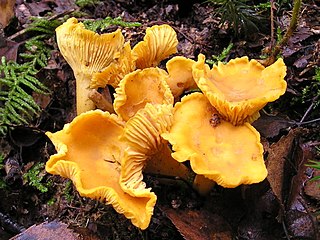
The Cantharellales are an order of fungi in the class Agaricomycetes. The order includes not only the chanterelles (Cantharellaceae), but also some of the tooth fungi (Hydnaceae), clavarioid fungi, and corticioid fungi (Botryobasidiaceae). Species within the order are variously ectomycorrhizal, saprotrophic, associated with orchids, or facultative plant pathogens. Those of economic importance include edible and commercially collected Cantharellus, Craterellus, and Hydnum species as well as crop pathogens in the genera Ceratobasidium and Thanatephorus/Rhizoctonia.

Tremella is a genus of fungi in the family Tremellaceae. All Tremella species are parasites of other fungi and most produce anamorphic yeast states. Basidiocarps, when produced, are gelatinous and are colloquially classed among the "jelly fungi". Over 100 species of Tremella are currently recognized worldwide. One species, Tremella fuciformis, is commercially cultivated for food.

Sigridea is a genus of lichenized fungi in the family Roccellaceae.
Diederimyces is a genus of fungi in the family Verrucariaceae. A monotypic genus, it contains the single species Diederimyces fuscideae.
Sarcopyrenia is a genus of lichenicolous (lichen-dwelling) fungi. It has 11 species. It is the only genus in Sarcopyreniaceae, a family in the order Verrucariales. Sarcopyrenia was circumscribed by Finnish lichenologist William Nylander in 1858, with Sarcopyrenia gibba assigned as the type species. Sarcopyreniaceae is one of the few families composed entirely of lichenicolous fungi.
Oevstedalia is a genus of fungi of uncertain placement in the subphylum Pezizomycotina. This is a monotypic genus, containing the single lichen species Oevstedalia antarctica. The genus was circumscribed by Damien Ertz and Paul Diederich in 2004. Previously classified in the Dothideomycetes, Oevstedalia was moved to Pezizomycotina incertae sedis due to the lack of DNA data available for the genus.
Zwackhiomyces is a genus of lichenicolous fungi in the family Xanthopyreniaceae. The genus was circumscribed by Martin Grube and Josef Hafellner in 1990, with Zwackhiomyces coepulonus assigned as the type species.
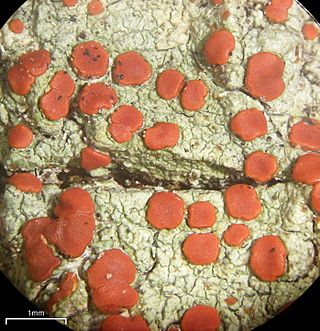
Ramboldia is a genus of lichen-forming fungi in the family Ramboldiaceae. The genus was circumscribed in 1994 by Gintaras Kantvilas and John Alan Elix. It was emended in 2008 by the inclusion of Pyrrhospora species containing the anthraquinone russulone in their apothecia and having a prosoplectenchymatous exciple. The family Ramboldiaceae was circumscribed in 2014 to contain the genus.
Llimoniella is a genus of fungi in the family Cordieritidaceae. The genus was circumscribed by lichenologists Josef Hafellner and Père Navarro-Rosinés in 1993.
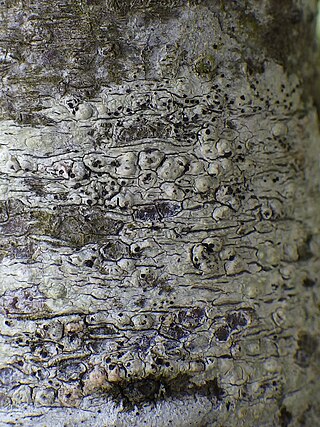
Skyttea is a genus of lichenicolous (lichen-dwelling) fungi in the family Cordieritidaceae. The genus was circumscribed in 1981 by lichenologists Martha Allen Sherwood, David L. Hawksworth, and Brian J. Coppins, with Skyttea nitschkei assigned as the type species.
Dictyonema is a genus of mainly tropical basidiolichens in the family Hygrophoraceae.

Phacopsis is a genus of lichenicolous (lichen-dwelling) fungi. They are parasites of members of the large lichen family Parmeliaceae, of which they are also a member. Originally proposed by Edmond Tulasne in 1852 to contain 3 species, Phacopsis now contains 10 species, although historically, 33 taxa have been described in the genus. Many of the species are poorly known, some of them having been documented only from the type specimen.

Marchandiomyces is a genus of fungi in the family Corticiaceae.
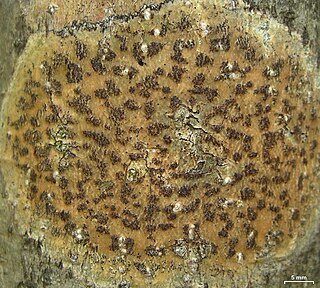
The Trypetheliales are an order of fungi in the class Dothideomycetes. Most of the species in the order form lichens, although some are lichenicolous fungi. Trypetheliales contains two families, Polycoccaceae and Trypetheliaceae. The order was circumscribed in 2008 by lichenologists Robert Lücking, André Aptroot, and Harrie Sipman.
Briancoppinsia is a fungal genus in the family Arthoniaceae. It is monotypic, containing the single species Briancoppinsia cytospora, a lichenicolous fungus that parasitises parmelioid lichens, as well as Cladonia, Lepra, and Lecanora conizaeoides, among others. The species was first described scientifically by Léon Vouaux in 1914 as Phyllosticta cytospora. The genus was circumscribed in 2012 by Paul Diederich, Damien Ertz, James Lawrey, and Pieter van den Boom. The genus was named for Brian John Coppins, who is, according to the authors, an "eminent British lichenologist and expert of lichenicolous fungi".
Karsteniomyces is a genus of lichenicolous fungi of unknown familial, ordinal, and class placement in the Ascomycota. The genus was circumscribed by David Leslie Hawksworth in 1980. The species of this genus are found in Europe.
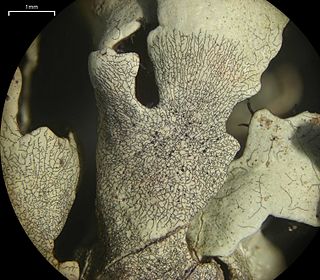
Lichenostigmatales is an order of fungi in the class Arthoniomycetes. It contains the single family Phaeococcomycetaceae. Lichenostigmatales was circumscribed in 2014 by Damien Ertz, Paul Diederich, and James D. Lawrey, with genus Lichenostigma assigned as the type. Using molecular phylogenetics, they identified a lineage of taxa in the Arthoniomycetes that were phylogenetically distinct from the order Arthoniales. Species in the Lichenostigmatales include black yeasts, lichenicolous, and melanised rock-inhabiting species.
Henricus (Harrie) Johannes Maria Sipman is a Dutch lichenologist. He specialises in tropical and subtropical lichens, and has authored or co-authored more than 250 scientific publications. He was the curator of the lichen herbarium at the Berlin Botanical Garden and Botanical Museum from 1983 until his retirement in 2010.
James Donald Lawrey is a biologist, specialising in lichens. He is known for leading long-term monitoring projects, taxonomy and studies of the evolution of the fungi in lichens.

Piccolia is a small genus of crustose lichens in the class Lecanoromycetes. First circumscribed by Italian lichenologist Abramo Bartolommeo Massalongo in 1864, it contains ten species. Due to a lack of molecular data, it has not been assigned to an order or family.
References
- ↑ Kirk PM, Cannon PF, Minter DW, Stalpers JA (2008). Dictionary of the Fungi (10th ed.). Wallingford, UK: CABI. p. 107. ISBN 978-0-85199-826-8.
- ↑ Diederich P, Lawrey JD (2007). "New lichenicolous, muscicolous, corticolous and lignicolous taxa of Burgoa s. l. and Marchandiomyces s. l. (anamorphic Basidiomycota), a new genus for Omphalina foliacea, and a catalogue and a key to the non-lichenized, bulbilliferous basidiomycetes". Mycological Progress. 6 (2): 61–80. doi:10.1007/s11557-007-0523-3. S2CID 2471396.
- ↑ Burkhardt, Lotte (2022). Eine Enzyklopädie zu eponymischen Pflanzennamen [Encyclopedia of eponymic plant names](pdf) (in German). Berlin: Botanic Garden and Botanical Museum, Freie Universität Berlin. doi:10.3372/epolist2022. ISBN 978-3-946292-41-8 . Retrieved January 27, 2022.